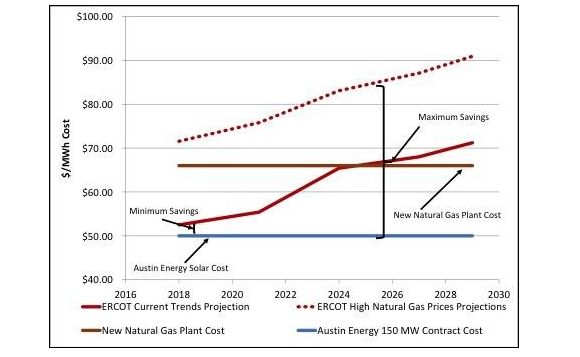The city of Austin may have just single-handedly propelled the Texas solar market into the top-ten leading states.
Last night, the Austin city council voted in favor of a resolution that would increase the city's rooftop and utility-scale solar targets by 800 megawatts over the coming years.
It creates a plan that would build a small paradise for distributed energy companies, including a utility-scale solar target of 600 megawatts by 2017, a rooftop solar target of 200 megawatts by 2020, explicit language enabling third-party solar ownership, a floor price for the value-of-solar tariff, and a mandatory strategy to procure 200 megawatts of fast-response storage.
The plan builds upon earlier climate goals created and revised since 2010. After Austin Energy signed a power-purchase agreement for 150 megawatts of solar at 5 cents per kilowatt-hour in May, city officials asked if they should require more solar that could provide a hedge against natural gas prices.
A task force convened by the city council took a look at the potential savings offered by solar PV and decided to sharply increase goals. The resolution was written by councilman Chris Riley and championed by energy experts and environmental groups alike.
"The 2014 Task Force found that solar energy represents a cost-competitive means of securing clean peak power hedging against the volatility of fuel-dependent thermal resources, and recommended that solar energy generation should be the new default generation resource through 2024."
Chad Blevins, a financial analyst with The Butler Firm, a law office devoted to renewable energy transactions, watched the proceedings closely. He said there were a lot more serious businesspeople involved in the goal-setting process this time around compared to previous targets.
“In the past, the people involved used environmental arguments to justify renewable goals. This time around, the case for renewables was based on economics – operational cost data from the utility, robust dynamic models projecting market prices and the very low PPA rates that we have seen from PV in response to recent RFPs," said Blevins.
That didn't mean that Austin Energy was fully on board. Although the municipal utility is seen as progressive in its support of renewables, executives were not enthusiastic about such a big increase in solar -- mostly because they were worried about managing it all on the grid. That's partly why the requirement for fast-response storage was added.
Advocates of the plan said it would save Austin ratepayers money and keep electricity prices in the range of the 50 percent lowest among Texas utilities.
The consumer advocacy group Public Citizen put together a cost analysis showing that ratepayers could save millions of dollars a year compared to building a new natural gas plant, assuming solar contracts are signed for $50 per megawatt-hour.

Cory Honeyman, a solar analyst with GTM Research, said the new goals will put Texas in the top-ten overall rankings and the top-five utility-scale solar rankings in the coming years.
"This plan cements Texas as an emerging leader in the near future," said Honeyman.
The plan is also representative of a broader shift for utility-scale solar around the country. According to Honeyman, there are now 3 gigawatts of large-scale projects in the pipeline in states like Georgia, North Carolina, Utah, Kentucky, and soon, Mississippi.
The surge in solar projects in states without the help of renewable portfolio standards is due to three reasons: price competition with natural gas, the need to fill in closing coal plants, and hedging against natural-gas price volatility.
"All three of the main reasons we see for justifying this goal in Austin is what we're seeing in other states, as well," said Honeyman.



